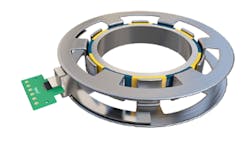Automotive-Qualified Hall Sensor Built for Safety-Critical Systems
The MLX91377 ASIL-ready Hall-sensor IC from Melexis is suitable for use in safety-critical automotive systems such as electric power-assisted steering, where the part supports accurate, dependable torque sensing to enable safe control in conventional and autonomous driving. Other contactless position-sensing use cases include acceleration, brake, or clutch pedal sensors, absolute linear position sensors, float-level sensors, non-contacting potentiometers, small-angle position sensors, and small stroke position sensors.
The sensor is sensitive to the magnetic flux density applied perpendicular to the IC. Thus, with the correct magnetic circuit, it can decode the absolute position of any moving magnet or linear displacement. It enables the design of non-contacting position sensors that are frequently required for automotive applications.
The MLX91377 consists of a Hall-effect magnetic front end, an analog-to-digital converter, a signal processor, and an output stage offering analog, SENT, or short PWM code (SPC) output. Through programming, the IC can also be configured to output an analog signal.
SPC is an extension of the SAE J2716 SENT protocol; the SPC protocol permits measurements to be taken and transmitted upon detection of a trigger pulse. As a result, up to four MLX91377 sensors can be synchronized up to 2 kHz, enabling simultaneous magnetic measurements with deterministic latency to ensure high accuracy. The four sensor outputs can be connected to one signal wire with each IC transmitting its data when addressed.
In addition, all ICs on a bus can be triggered to perform a magnetic signal acquisition at the same time, thereby allowing for zero latency between IC measurements. Latency is the average lag between the movement of the detected object (magnet) and the response of the sensor output.
In SPC mode, the MLX91377 starts data acquisition once the trigger pulse is received, regardless of the configured mode. It will send the acquired data in the same SENT frame. Low noise and a high refresh rate also allow for high control-loop speeds, enabling systems to deliver fast response times with minimal filtering.
Multi-point magnetic field linearization and magnet drift compensation ensures high performance and accuracy at room temperature and throughout an operating range of −40 to 160°C. Its absolute maximum ratings include a supply and output voltage range of −18 to 28 V.
Programmable measurement range and multi-point calibration enhance flexibility for designers. Furthermore, a variety of output protocols enables one IC to be used in multiple applications, reducing requalification efforts and costs.
Programming of the IC is accomplished with the use of the company’s PTC-04 programmer and its Hall-06 daughterboard. The PTC-04 programmer contains its own programmable power supply and measurement circuitry. It’s similar to a standard EEPROM programmer, but adds special features such as 16-bit voltage and current measurement capability, and configuration options that will accommodate users from the prototyping phase directly into production.
An IBM-compatible PC is required (not included) to load software to the programmer and control the functions of the programmer. The main daughterboard has two connectors to the interface with the application—it’s mounted on the two connectors.
The MLX91377 is offered as an ASIL-C or ASIL-B SEooC (Safety Element out of Context - ISO 26262) component, depending on the output format. SEooC is a safety-related element not developed in the context of a particular system or vehicle as described in ISO 26262 Part 10, "Guideline on ISO 26262,” Chapter 9 "Safety element out of context."
The MLX91377, qualified to AEC-Q100 Grade 0, can detect internal failures and enters a safe state to prevent unintended vehicle behavior. It has a 48-bit programmable identification number (user identification numbers are freely usable by customers) for traceability purposes. The available dual die TSSOP-16 package offers two fully redundant dies to enable support for safety-critical applications like steering and braking systems. The two fully independent dies ensure that one channel remains operational in the event of a fault condition.

